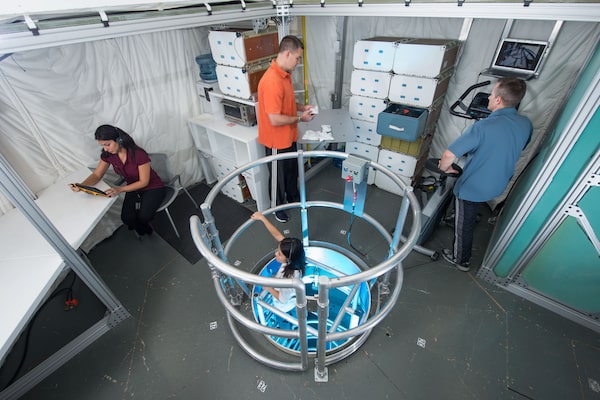
Scientists say the goal of the research is to develop systems that can detect subtle signs of tension and help redirect teams of astronauts that are heading for problems before group cohesion breaks down and performance is impaired.Bill Stafford/NASA/Johnson Space Centre
By definition, astronauts who embark on the first crewed mission to Mars will encounter a combination of challenges and risks that humans have never experienced before, including years of reduced gravity and exposure to the hard radiation environment of deep space.
Yet, until recently, scientists have had little to say about another serious challenge that could emerge during such an expedition – the risk that astronauts pose to each other when their ability to work together breaks down far from home and they have limited support from Earth to resolve a crisis.
Now, controlled experiments with small groups of people kept in isolation together for weeks or months at a time, as well as studies of teams working in remote locations such as the Antarctic are beginning to shed light on what kind of issue and behaviour patterns participants and mission managers should expect to see at various stages of an expedition to Mars.
Scientists say the goal of the research is to develop systems that can detect subtle signs of tension and help redirect teams of astronauts that are heading for problems before group cohesion breaks down and performance is impaired.
“Like weather forecasting, we’re not just describing what is happening … we are predicting what is happening,” said Noshir Contractor, a professor of behavioural science at Northwestern University in Evanston, Ill. “Our computer models are geared to see what we can do to preempt a potential team issue.”
Dr. Contractor is among the researchers working with the Human Exploration Research Analog (HERA) project housed at NASA’s Johnson Space Center in Houston. Together with colleagues, he presented some of his findings on Sunday at the annual meeting of the American Association for the Advancement of Science in Washington.
The HERA project, which began in 2014, involves crews of four people living together in a close, isolated habitat for up to 45 days at a stretch. During that time, communications with the outside work can be progressively delayed for up to five minutes in order to simulate what future Mars explorers will face as they are carried ever farther from home.
In reality, a Mars mission will require a crew to spend a minimum of three years together with no possibility of an early exit because the journey will be timed to when Earth and Mars are favourably positioned for an interplanetary voyage. In the middle of the mission, the two-way travel time for radio signals to and from Earth will grow to more than 40 minutes. Under such conditions, astronauts will have to depend on their crewmates to a greater extent than on any previous human space mission.
Leslie DeChurch, a psychologist with the project who is also based at Northwestern, said enough people have gone through the HERA experiment to make good predictions about what could happen in deep space. Among them is the recognition that a team is often most vulnerable during the third quarter of a mission – regardless of how long the mission lasts. In the context of a Mars mission, this period would encompass part of the return journey, when the novelty of the experience has worn off but there’s still a long way to go.
“That’s when people start to feel like, ‘I don’t want to play anymore,’” she said.
At such times, the ability of crewmembers to combine their expertise and work together to solve problems declines measurably. The results seem largely independent of gender. While HERA has run the experiment with one all-male and one all-female team, both the best and worst performing teams have been those made up of men and women, Dr. DeChurch said.
The HERA results are mirrored in even longer duration simulated missions conducted at a remote high altitude facility called the Hawaii Space Exploration Analog and Simulation (HI-SEAS) operated by the University of Hawaii atop Mauna Loa. Last year, what was to be an eight-month simulation for a six-person crew came to an abrupt end when a crewmember was injured by an electric shock. But previous versions of the experiment have provided a wealth of data on what can go wrong when a small group of people must learn to get along to accomplish a shared goal under stress.
Steve Kozlowski, an organizational psychologist at Michigan State University who is working with HI-SEAS, said every run of the experiment that has exceeded six months has experienced a fracturing of team cohesion. The disengagement generally begins with a couple of crew members and then spreads to the entire group by the end of the mission.
“There’s cause for concern,” in terms of what might happen to a crew sent to Mars, Dr. Kozlowski said.
Jeffrey Johnson, an anthropologist at the University of Florida in Gainesville, studies the equivalent effects on team dynamics at the South Pole research station and other Antarctic facilities. He said a key element that has enabled some teams to resist such fracturing is the presence of a well-loved team member with a strong sense of humour that can diffuse tension and serve as the glue that binds a team together.
Dr. Contractor added that, collectively, the new findings suggest the way NASA initially selected astronauts – as famously portrayed in the 1979 book The Right Stuff as an all-male cadre of square-jawed, stoic fighter pilots – was not a recipe for future missions beyond the Moon.
“Is the right stuff still the right stuff for a team that would go to Mars?” Dr. Contractor said. “I think we’re pretty confident that it is not.”
 Ivan Semeniuk
Ivan Semeniuk